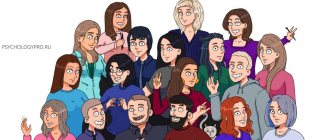A lot depends on your emotional state: decision-making, responding to the actions and behavior of other people, productivity and even well-being. If we stop controlling our experiences, they begin to control us, which often leads to not the most pleasant consequences. In this article, I will classify and describe the types of emotions and human feelings in psychology, and explain their main features in diagrams and tables.
What is it: concept
Emotionality is the reaction of the psyche to various circumstances of life, which determines the direction of an individual’s actions. It is connected with the outside world through relationships of interdependence: what is happening around (the environment, the general atmosphere, people, events) directly affects the psycho-emotional state, which, in turn, can have an impact on the surrounding space.
There are some differences between emotions and feelings: the former are short-term, the latter are stable and longer lasting.
Facial expressions hide human emotions
Facial expressions help hide a person's emotions. With age, each individual learns to control emotions and hide them. One of the most common positive emotions is interest. Thanks to this emotion, people are able to develop their skills and intelligence.
Interest is a motivating emotion. Interest helps you work and be creative. Visual interest is characterized by slightly tense or raised eyebrows, pursed lips or a slightly open mouth. This facial movement lasts less than 5 seconds, but the emotion itself is experienced much longer.
Role and nature
Emotionality is a complex mental process consisting of three elements:
- Physiological. Reflects the changes that occur in the body when certain moods manifest themselves: breathing rate, heart muscle contractions, hormonal changes, metabolic processes).
- Psychological. Characterizes the experience itself: anger, joy, sadness.
- Behavioral. Manifests itself in facial expressions, gestures and actions (inhibited reaction, activity, aggression, crying).
The first two components represent the internal formation of the emotional state, while the third is responsible for its external manifestations. Often a person finds himself in a situation where he cannot openly express his feelings. There is a need for a deterrent or time delay. But one way or another, it is necessary to throw out the excess energy that arises inside. This can be done through physical activity or performing household activities (cleaning, switching to a hobby).
Emotions have a number of special characteristics:
- Polarity. They have a positive or negative connotation, although there may also be contradictions (you can love a person, but at the same time feel resentment, anger or anxiety towards him).
- Energy charged. There are sthenic experiences (causing increased activity - fury, irritation, inspiration, delight) and asthenic (causing passivity - sadness, fear).
- Integrity. Emotionality involves the interaction of all psychophysical aspects of the personality, which affect the entire body, manifesting itself in actions, in the body, and in the way of thinking.
- Inalienability. Emotions cannot be separated from other processes occurring in the psyche. They accompany everything - both the work of the senses (separating the pleasant from the unpleasant) and the functioning of the intellect (causing interest or boredom).
Block 7. Emotions. Fear.
Fear is a negative emotional state that occurs in response to real or imagined danger.
With fear, a person is afraid. Fear arises when the subject perceives an object as posing a threat to health, life, well-being of one’s own and “THIS.” Fear can be divided into three options:
– Horror is the highest degree of fear. It manifests itself in the fact that a person increasingly loses the ability to consciously control his own behavior. His entire mental space is filled with the cause of horror.
– Actually, fear is a reaction in which a person strives to quickly escape from a source that poses a threat.
– Anxiety/worry is an experience associated with a potential danger that is not clearly localized in space and time.
Functions
- Subjective. The emotional state contributes to the formation of a certain point of view in the individual, and also allows one to establish connections with the outside world. Everything that happens is perceived by a person through the prism of his sensations.
- Communicative. With the help of such mental properties as empathy, we can determine the mood in which another individual is, which helps to establish contact or even manipulate others.
- Behavioral. Determining the vector of behavior, separating the pleasant from the unpleasant, the important from the unimportant.
Block 1. Emotions. Joy.
Joy is a positive emotional experience that arises in situations with complete satisfaction of current needs.
Joy can be divided into several options:
– Delight – a person is abundantly satisfied with what is happening. The subject's "cup of expectations" is overflowing.
– Actually, joy – the “cup of expectations” is filled as much as planned.
– Laughter – a person suddenly becomes satisfied.
– Satisfaction, “quiet joy” - a person is in a state of calm satisfaction with the fact of the filled “cup of expectations.”
VIDEO “Negotiations. How to overcome objections?!”
Responsive WordPress Gallery Plugin
Classifications: all main types of emotions
Throughout life we experience a colossal amount of experiences. Not all of them can be described in two words; many are contradictory and ambiguous.
There are many different approaches to systematizing and classifying emotional states. The simplest of them is presented in the table below.
| Type | Description | Examples |
| Positive | They bring satisfaction, together they create a feeling of contentment with what is happening, happiness. | Sympathy, love, delight, inspiration. |
| Negative | They create general dissatisfaction and bad mood. | Fear, sadness, envy, grief, sadness, resentment, anger, melancholy. |
| Neutral | Do not directly influence the actions of the individual. | Indifference, surprise, interest. |
Dodonov classification
This diagram is more common in psychology and shows the distribution of types of experiences by function:
- Communicative (occurs in the process of communication).
- Altruistic (associated with the desire to benefit people).
- Praxic (appears when the plan is successfully completed).
- Gloric (need for self-affirmation).
- Pugnetic (attraction to risk, danger).
- Romantic (imply a desire for something new and unusual).
- Aesthetic (the appearance is determined by interaction with the sphere of art).
- Gnostic (formed with a desire for knowledge).
- Akizivnye (based on accumulation, gathering).
- Hedonic (aimed at experiencing pleasure).
Leontief classification
According to this approach, types of emotions are divided based on the source that generated them. Experiences can be caused by:
- the degree of satisfaction of certain needs;
- other people’s desires and the individual’s attitude towards them;
- relationships;
- contempt;
- drawing analogies between the real and the ideal (compliance of the individual with internal requirements, expectations, norms);
- comparison of one’s “I” with social standards.
However, this division option raises many questions because it is unclear. For example, what to do in the case when the same feeling can arise in building relationships and during self-analysis?
Psychologist Daria Milai
Make an appointment
Block 5. Emotions. Disgust.
Disgust is a negative emotional state that arises upon contact with objects, subjects, phenomena, characterized by antagonistic rejection due to differences in assessments and principles from a moral, ethical, ideological position.
Disgust is closely related to food, water, i.e. with those resources that need to be regularly replenished throughout life. The quality of food, its edibility, and usefulness are factors of high importance for a prosperous existence.
Disgust in the process of evolution contributed to the survival of individuals and species. This emotional experience is a signal that regulates the suitability of the product for subsequent consumption, establishing contact, or categorical denial.
Disgust is no less influenced by sociocultural factors that differentiate acceptable forms of behavior from those that are categorically unacceptable and disgusting.
Disgust helps a person to reject something that can cause him harm or damage. In disgust, the subject strives to break off contact with the object and refuse future encounters. People of different religious faiths may be disgusted by “ALIENS”, for example, “infidels”. The subject perceives a colleague at work who has committed an immoral act as a disgusting person. Disgusting foods cause nausea and vomiting. Disgust intensifies as the internal dialogue associated with the “bad” object and situations in general intensifies.
Forms and examples of emotional processes
- The emotions themselves. They can appear both in a collision with really existing situations, and when thinking about imaginary, non-existent events. They allow you to express satisfaction or dissatisfaction with what is happening, and give it an assessment based on the individual’s personal experience.
- Feelings. They are always stable (not momentary) and are distinguished by their brightness of expression. You can feel passion, love, resentment.
- Mood. The longest lasting mental state that affects the actions and well-being of the individual as a whole over a long period.
- Affects. An extreme form of expression that encourages short-term, uncontrollable changes in behavior. Completely irrational and very violent.
The relationship between the sensual and emotional sides
A more stable manifestation of emotionality is feelings. They, as a rule, arise on the basis of the needs of the second level (spiritual) and form a certain position, a person’s point of view. Classified according to the subject they are aimed at:
- Intelligent. Occur during mental activity (surprise, doubt, curiosity).
- Aesthetic. Their development is associated with the perception of beauty (love of art or some of its aspects, admiration for beauty).
- Moral. They characterize an individual’s attitude towards the behavior of other people. This assessment in most cases depends on the norms existing in society (humanity, altruism, friendship, compassion, pity, love).
There are also such concepts as state and reaction. They differ in the degree of duration and correlate the needs and aspirations of the individual with his capabilities and resources at the moment.
Block 8. Emotions. Shame.
Shame is a negative emotional state characteristic of situations when a person realizes that his own thoughts and actions do not correspond to his ideas - beliefs - beliefs about normative behavior or the expectations of significant people.
There are different types of shame:
– Guilt is a person’s experience of his own behavior or the behavior of “THIS OWN” as not corresponding to established norms, rules, and assigned tasks.
– Conscience is a person’s complex experience of the relationship between personal thoughts, actions and cultural, religious, social norms, as they are presented in their own cognitive model of the world.
– Shame itself is an acute experience of one’s own negative assessment of one’s actions.
Order the training “Negotiations - Partnership”
Izard's Differential Emotions
The scientist identified the following fundamental experiences:
- Interest. This feeling is directly related to a person’s sociality. Only with him is it possible to acquire new skills, knowledge, skills, and develop physically and mentally.
- Pleasure. It is a kind of synonym for joy. Creates a positive background, a good, cheerful mood. Appears when there is an opportunity to satisfy an important need for an individual. It can increase self-confidence, facilitate the process of establishing communication, and get rid of anxiety and stress.
- Astonishment. A short-term reaction to a collision of the psyche that has just occurred with a certain unexpected event, phenomenon or action.
- Anger. A negative state characterized by the impossibility of getting what you want, failure, or dissatisfaction with someone's behavior. The uncontrollable form is rage.
- Disgust. It arises due to interaction with an object that is unpleasant for the individual. Accompanied by a thirst to get rid of the provoking factor.
- Contempt. It manifests itself in the process of disagreement between people’s beliefs and actions.
- Shame. It is formed due to the inconsistency of certain aspects of the personality with one’s own requirements or public opinion. It is often accompanied by an unpleasant feeling of helplessness.
- Guilt. It arises as a result of condemnation of one’s own behavior. Brings with it repentance.
- Fear. Associated with the awareness of an emerging or imaginary threat to life.
- Grief. Reaction to negative events.
There is also a scale that allows you to determine the prevailing emotional state of an individual.
| Manifestations | Sum of points | Category | |||||
| Attentive | Concentrated | Assembled | C1 Interest | ||||
| Enjoying | Happy | Glad | C2 Pleasure | ||||
| Surprised | Amazed | Stricken | C3 Surprise | ||||
| Sad | Sad | Broken | S4 Grief | ||||
| Excited | Angry | Insane | C5 Anger | ||||
| Dislike | Disgust | Disgust | C6 Disgust | ||||
| Contemptuous | Neglecting | Haughty | S7 Contempt | ||||
| Frightened | Horrified | In panic | C8 Fear | ||||
| Shy | Timid | Shy | C9 Shame | ||||
| Sorry | Guilty | Repentant | C10 Wines | ||||
Face-to-face consultation
What are the features and advantages of face-to-face consultation?
Find out more
Skype consultation
What are the features and benefits of Skype consultations?
Find out more
To determine your emotional state, you need to evaluate your current state of health in each column:
1 – absolutely not suitable;
2 – more likely yes than no;
3 – consent;
4 – completely true.
Next, count the sum of points in the lines of the list and calculate the coefficient using the formula:
KS = (C1 + C2 + C3 + C9 + C10) / (C4 + C5 + C6 + C7 + C8)
If the obtained value is >1, then the result is assessed as positive; if <1, there is a negative mood, close to depression.
Block 3. Emotions. Sadness.
Sadness is a negative emotional state that arises in a situation of inability to satisfy key life support needs.
Sadness manifests itself in the present in relation to past events, when there was a loss of access to target resources, or predictively to the future, when the inability to gain access to valuable resources is expected. There are also several options for sadness:
– Grief/grief – this experience is associated with the loss of primarily a living being that was of great value to a person.
– Longing – this experience is characterized by a long period when a person cannot satisfy his own needs and this stimulates him to change this situation.
– Dejection – a person is in a state of passive contemplation of the lack of access to subjectively significant target resources.
– Actually, sadness – a person suffers due to not getting what he wants.
– Sadness – this experience represents the mildest degree of sadness. Usually accompanies the loss of access to a result whose value is not significant.
Emotional reactions
- Lability is the variability of the manifestation of experiences. They always fluctuate over a fairly wide range (from light sentimentality to hysteria).
- Monotony is monotony, static or no sensory responses to what is happening.
- Responsiveness and empathy - the ability to quickly and flexibly respond to external influences, the ability to put oneself in the place of another, to empathize.
- Viscosity – focusing on a long-term feeling (for example, instead of reacting to the situation, a person returns to old grievances, failures).
- Coarsening is the inability to realize the appropriateness and admissibility of expressing emotions, loss of restraint and delicacy.
- Alexithymia is difficulty in identifying one’s feelings and their expression, the inability to distinguish experiences from physical sensations.
- Rigidity – immobility and limited range of response.
Sometimes a person’s behavior is demonstrative in nature, which is associated with his social functions. That is, people portray a certain involvement and emotionality in a situation that requires it. In this case, they speak of the existence of an emotional action, and not a reaction.
Emotions, their functions and properties. Theories of emotions
- home
- State exam in the specialty Psychology of Personality (bachelor's degree)
- General psychology
->
->
Answer plan:
1) The concept of emotions
2) Properties of emotions
3)Functions of emotions
4) Classification of emotions
5) The difference between emotions and feelings
1) Emotions are the process of reflecting a person’s subjective attitude towards objects and phenomena of the surrounding world, other people and oneself in the form of direct experience (according to B.D. Karvasarsky). Emotions form an integral part of human existence. Everything that a person encounters in everyday life evokes a certain attitude in him. Some objects and phenomena evoke sympathy, others, on the contrary, disgust. Some arouse interest and curiosity, others indifference. Thus, the most essential characteristic of emotions is their subjectivity.
2) Properties of emotions
1. Polarity - emotions differ in a positive or negative sign: pleasure-displeasure, fun-sadness. Emotional experiences are ambiguous. The same object can cause inconsistent, contradictory emotional relationships. This phenomenon is called ambivalence (duality) of feelings. Typically, ambivalence is caused by the fact that individual features of a complex object have different effects on a person’s needs and values.
2. Energy saturation - with the help of emotions, a person is capable of tension and release - and this is where the energy of emotions is manifested. Emotions can increase a person’s activity and tone and decrease it. In this regard, a distinction is made between sthenic emotions, characterized by an increase in activity (delight, anger) and asthenic emotions, accompanied by a decrease in activity (sadness, sadness).
3. Integrity - emotions cover the entire body and give color to experiences. All human psychophysiological systems participate in emotional experience. So, for example, indicators of the emotional state can serve as: shifts in pulse rate, breathing, body temperature, galvanic skin response, etc.
3)Functions of emotions
1. Regulatory: under the influence of negative emotional states, a person may develop the prerequisites for the development of various diseases. Conversely, there are a significant number of examples where the healing process is accelerated under the influence of an emotional state.
2.Evaluative: expressed in a generalized assessment of events. Thanks to this, emotions make it possible to determine the usefulness and harmfulness of factors affecting a person and react before the harmful effect itself is determined. For example, a person crossing the road may experience varying degrees of fear depending on the current traffic situation.
3. Incentive or stimulating
4. Communicative: facial and pantomimic movements allow a person to convey his experiences to other people, inform them about his attitude to objects and phenomena of the surrounding reality.
4) Classification of emotions
Most authors, citing one or another classification of emotions, note four main, fundamental human emotions: anger, fear, sadness, joy.
| Characteristics of emotions | Types of emotions |
| Sign | Positive, negative, ambivalent |
| Modality | Joy, fear, anger. |
| Influence on behavior and activity | Sthenic, asthenic |
| Degree of awareness | Conscious, unconscious |
| Objectivity | Subjective, non-subjective |
| Degree of randomness | Voluntary, involuntary |
| Origin | Congenital, acquiredPrimary, secondary |
| State of the art | Inferior, superior |
| Duration | Short term, long term |
| Intensity | Weak, strong |
Characteristics of emotions as a basis for classification
ADDITIONAL MATERIAL to QUESTION 11. Theories of the emergence of emotions and the difference between emotions and feelings. Classification of emotions
Theories of emotion
Cannon-Bard theory. Cannon believed that bodily processes during emotions are biologically expedient, since they serve as a preliminary adjustment of the entire organism to a situation where it will be required to expend increased energy resources. At the same time, emotional experiences and corresponding organic changes, in his opinion, arise in the same brain center - the thalamus.
Later, P. Bard showed that in fact, both bodily changes and the emotional experiences associated with them arise almost simultaneously, and of all the brain structures, it is not even the thalamus itself that is most functionally connected with emotions, but the hypothalamus and the central parts of the limbic system. systems. Later, in experiments conducted on animals, X. Delgado found that with the help of electrical influences on these structures it is possible to control such emotional states as anger and fear.
Peripheral theory of James - Lange. W. James and, independently of him, G. Lange proposed a “peripheral” theory of emotions, according to which the emergence of emotions is caused by changes in the motor sphere (including in the sphere of involuntary acts), which are caused by external influences. The sensations associated with these changes are emotional experiences. James expressed the essence of his theory with the following phrase: “We feel sad because we cry, we are afraid because we tremble, we are happy because we laugh.” Those. It is organic changes, according to this theory, that are the root causes of emotions: first, under the influence of external stimuli, changes characteristic of emotions occur in the body, and only then, as a consequence, does the emotion itself arise. The James-Lange theory played a positive role, pointing out the connection between three events: an external stimulus, a behavioral act and an emotional experience. Its weak point remains the reduction of emotions only to the awareness of sensations arising as a result of peripheral reactions. Sensation appears here as a primary phenomenon in relation to emotion, which is considered as its direct derivative.
Schechter's cognitive-physiological theory . S. Schechter revealed the role of memory and human motivation in emotional processes. The concept of emotions proposed by S. Schechter was called “cognitive-physiological”. According to this theory, the resulting emotional state, in addition to perceived stimuli and the bodily changes generated by them, is influenced by a person’s past experience and his subjective assessment of the current situation. In this case, the assessment is formed on the basis of interests and needs that are relevant to him. Indirect confirmation of the validity of the cognitive theory of emotions is the influence on a person’s experiences of verbal instructions, as well as additional information, on the basis of which a person changes his assessment of the situation.
Information concept of emotions by P. V. Simonov. According to this theory, emotional states are determined by the quality and intensity of the individual’s actual need and the assessment he gives of the likelihood of its satisfaction. A person makes an assessment of this probability on the basis of innate and previously acquired individual experience, involuntarily comparing information about the means, time, and resources supposedly necessary to satisfy the need with the information received at the moment. For example, the emotion of fear develops when there is a lack of information about the means necessary for protection.
P. V. Simonov’s approach was expressed in the formula:
E = P(In - Is)
Where E is emotion, its strength and quality;
P - the magnitude and specificity of the current need;
In - information necessary to satisfy an urgent need;
IS - existing information, i.e. information that a person currently has.
The consequences arising from the formula are as follows: if a person does not have a need (P = 0), then he does not experience emotions (E = 0); emotion does not arise even in the case when the person experiencing the need has full opportunity to realize it. If the subjective assessment of the likelihood of need satisfaction is high, positive feelings appear. Negative emotions arise if the subject negatively evaluates the possibility of satisfying a need. Thus, consciously or unconsciously, a person constantly compares information about what is required to satisfy a need with what he has, and depending on the results of the comparison, he experiences different emotions.
To date, there is no single point of view on the nature of emotions. Research into emotions continues to be intensive. The currently accumulated experimental and theoretical material allows us to talk about the dual nature of emotions. On the one hand, these are subjective factors, which include various mental phenomena, including cognitive processes, organizational features of a person’s value system, etc. On the other hand, emotions are determined by the physiological characteristics of the individual.
The difference between emotions and feelings
Two concepts are widely used in the literature: “feelings” and “emotions”, which should be distinguished from each other. Emotions are a broader concept, while feelings are one of the manifestations of emotional experiences. In practical life, emotions usually mean a wide variety of human reactions - from violent explosions of passion to subtle shades of mood. The main difference between emotions and feelings is that emotions, as a rule, have the nature of an indicative reaction, i.e. carry primary information about the lack or excess of something, therefore they are often vague and insufficiently realized. Feelings have a clearly expressed objective character. They reflect a stable attitude towards any specific objects (real and imaginary). A person cannot experience feelings at all if they are not related to someone or something. For example, a person is unable to experience the feeling of love if he does not have an object of affection. In the same way, he cannot experience hatred if he does not have what he hates. Feelings arose and were formed in the process of cultural and historical development of man. In the individual development of a person, feelings act as a significant factor in the formation of the motivational sphere. A person always strives to engage in an activity that he likes and gives him positive feelings.
Feelings also play a significant role in building contacts with other people. It should be noted that feelings are always individual. What one person likes may cause negative feelings in another. This is explained by the fact that feelings are mediated by the system of value systems of a particular person.
Depending on the sphere to which they relate, feelings are divided into:
1. Aesthetic. Perception of the beautiful world. A sense of beauty, greatness, baseness, comic, tragic.
2. Intelligent . Accompany the process of cognition, imagination and creativity. Feelings of amazement, doubt, bewilderment, disdain, curiosity.
3. Moral. They characterize the subject’s activity in relation to another person, people and society as a whole. A sense of duty, conscience, envy, patriotism, superiority.
4. Praxic . They manifest themselves in practical activities and reflect an emotional attitude to both the results and the labor process.
Many authors also include passion - another type of emotional state found only in humans. Passion is a fusion of emotions, motives, feelings concentrated around a certain type of activity or subject. S.L. Rubinstein wrote that “Passion means impulse, passion, orientation of all aspirations and forces of the individual in a single direction, concentrating them on a single goal...”.
Classification of emotions
Classification by duration
1. Emotional reactions - direct experience of any emotion. They are based on primary needs, as a rule, short-term and reversible and associated with current circumstances (fright reaction in response to a scream).
Affect is the most powerful type of emotional reaction, intense, violent and short-term emotional outbursts that affect a person’s consciousness and activity, and are accompanied by changes in the functioning of the motor, endocrine, cardiovascular and other systems of the body. The emergence of affect is associated with evaluative moments, with the personal meaning of what is happening. The distinctive features of affect are its situational nature, generality, high intensity and short duration. According to the content, one can distinguish the affects of joy, fear, anger, despair, ecstasy, etc.
2.Emotional states are longer and more stable. They coordinate the needs and aspirations of a person with his capabilities and resources at any given moment in time.
Mood is the most long-lasting, or “chronic,” emotional state that colors all behavior. Mood is characterized by less intensity and less objectivity. It reflects an unconscious, generalized assessment of how circumstances are currently shaping up. The mood can be joyful or sad, cheerful or depressed, cheerful or depressed, calm or irritated, etc. The mood depends on the general state of health, on the functioning of the endocrine glands and, especially, on the tone of the nervous system. Moods can vary in duration. The stability of mood depends on many reasons - a person’s age, the individual characteristics of his character and temperament, willpower, and the level of development of the leading motives of behavior. Mood can color a person's behavior for days or even weeks. Moreover, mood can become a stable personality trait. It is this feature of mood that is meant when people are divided into optimists and pessimists.
3. Emotional properties are the most stable characteristics of a person, reflecting the individual characteristics of emotional response, typical for a particular person. Reactivity, excitability and lability-rigidity.
Emotional reactivity - the speed of emotional response, the duration of the reaction (response).
Emotional excitability is the speed of emotional activation, i.e. speed of emotion emergence.
Emotional lability is the mobility of emotions, the replacement of one emotion by another. Its opposite is emotional rigidity, i.e. viscosity, persistence of emotions.
Emotional properties are based on the characteristics of the nervous system and human temperament.
Characteristics of emotions as a basis for classification
Modality. In the psychological literature, there are different approaches to how many and which of the emotional modalities are basic. Different authors name different numbers of basic modalities – from two (pleasure-displeasure) to ten. In Russian psychology, V.D. Nebylitsyn proposed to consider three main modalities: joy, anger, fear. The rest of the emotions are their derivatives or combinations. The question of the need to also include the emotion of sadness in the structure of the initial modalities of the emotional sphere remains debatable. According to O.P. Sannikova, “emotions of such patterns as “joy” and “sadness” belong to the same qualitative continuum, occupying polar positions in it.” Other authors believe that the emotion of sadness has its own distinctive characteristics (L. M. Abolin, 1987; N. M. Rusalova, 1979, etc.). A.I. Makeeva considers the following emotional modalities as the main ones: joy, surprise, fear, suffering, anger, contempt. A. T. Zlobin also names six basic emotions: fear, sadness, anger, shame, joy, fearlessness.
In foreign psychology, three main modalities of emotions were identified by J. Watson (fear, rage and love) and J. Gray (anxiety, joy-happiness and horror-anger). R. Woodworth, when trying to classify the facial emotional manifestations of people, was able to identify the following main groups: 1) love, joy, happiness; 2) surprise; 3) fear, suffering; 4) anger, determination; 5) disgust; 6) contempt. R. Plutchik names eight primary emotion modalities corresponding to the main prototypes of adaptive behavior: acceptance, disgust, anger, joy, fear, grief, surprise, interest.
However, the most developed, focused on individual emotional modalities, is the “theory of differential emotions” by K. Izard, which identifies ten fundamental emotions:
1) interest - an intellectual emotion, a feeling of involvement, which increases a person’s ability to perceive and process information coming from the outside world, stimulating and regulating his activity;
2) joy is an emotion characterized by the experience of psychological comfort and well-being, a positive attitude towards the world and oneself;
3) surprise - an emotion caused by sudden changes in stimulation and prepares a person to effectively interact with new or sudden events;
4) sadness - the experience of loss (temporary/permanent, real/imaginary, physical/psychological) of the object of need satisfaction, causing a slowdown in mental and physical activity, the general pace of a person’s life;
5) anger - an emotion caused by a state of discomfort, limitation or frustration, characterized by mobilization of energy, high levels of muscle tension, self-confidence and generating readiness for attack or other forms of activity;
6) disgust - an emotional reaction of rejection, removal from physically or psychologically harmful objects;
7) contempt – a feeling of superiority, value and significance of one’s own personality in comparison with the personality of another person (devaluation and depersonalization of the object of contempt), which increases the likelihood of committing “cold-blooded” aggression;
 fear is an emotion characterized by a feeling of insecurity, uncertainty about one’s own safety in a situation of threat to the physical and/or mental self with a pronounced tendency to escape;
fear is an emotion characterized by a feeling of insecurity, uncertainty about one’s own safety in a situation of threat to the physical and/or mental self with a pronounced tendency to escape;
9) shame - the experience of one’s own inadequacy, incompetence and uncertainty in a situation of social interaction, one’s inconsistency with the requirements of the situation or the expectations of others, which contributes to both compliance with group norms and has a destructive effect on the very possibility of communication, giving rise to alienation, the desire to be alone, to avoid others ;
10) guilt - an experience that arises in a situation of violation of the internal moral and ethical standard of behavior, accompanied by self-condemnation and repentance.
Depending on the degree of awareness, emotions are divided into conscious and unconscious. However, awareness of emotional experiences is not subject to the all-or-nothing principle. Therefore, there are different degrees of awareness of emotions and different forms of its distortion. Full awareness presupposes both a comprehensive description of the emotion itself and an understanding of the connections between the emotion and the factors that caused it, on the one hand, and between the emotion and the actions to which it prompts, on the other. A change in the awareness of emotional experiences, according to J. Reikowski, can manifest itself in the following forms: 1) unawareness of the very fact of the emergence of emotions (for example, a person does not notice his anxiety, emerging feelings, etc.); 2) incorrect categorization of emotions (a person interprets resentment as moral indignation, fear of failure as a lack of interest); 3) incorrect interpretation of the cause of the emotion (for example, a person believes that his anger is caused by someone’s unworthy behavior, when in fact it is caused by the fact that he was not given enough attention); 4) incorrect interpretation of the connection between the emotion and the action caused by it (for example, the parent believes that he is punishing the child “for his own good,” when in fact he does it in order to show his superiority).
Objectivity. Depending on the connection of emotional experiences with a specific object, emotions can be objective or non-objective.
V. K. Vilyunas proposed a functional classification of emotions (according to their functional characteristics and role in the regulation of activity). Considering emotions as a mediator between needs and activities to satisfy them, the author divides them into: 1) leading - experiences that color the objects of need in the image of the environment and thereby transform them into motives. Such experiences are a direct subjective correlate of the need, objectifying it in objective activity. Leading emotions precede activity, encourage it and are responsible for its general direction; 2) derivatives - situationally significant experiences that arise in the process of activity and express the subject’s attitude to individual conditions that facilitate or hinder its implementation, to specific achievements in it, to existing or possible situations.
Degree of randomness. Depending on the possibility of voluntary regulation and control of behavior, emotions are voluntary and involuntary. However, the voluntariness of emotional response, like awareness, is a continuous scale and has varying degrees of severity.
Based on their origin, emotions are divided into innate, associated with the implementation of instinctive response programs, and acquired , formed under the influence of individual and social experience.
According to G. A. Vartanyan and E. S. Petrov, primary emotions are genetically determined and strictly related to the disruption or restoration of homeostasis in the body. Such experiences are functionally inextricably fused with specialized unconditioned reflex reactions and are non-probability (occur in response to a certain external stimulus with a probability equal to 1). Secondary emotions are formed on the basis of primary ones as a result of individual adaptation experience.
According to the level of development, emotions are divided into lower - associated primarily with biological processes in the body, with the satisfaction or dissatisfaction of a person’s vital needs, and higher - associated with the satisfaction or dissatisfaction of a person’s social and spiritual needs. The component composition of lower and higher emotions is also different: higher emotions include a “subjective link” (assessment of one’s emotional state) and various cognitive links (providing a probabilistic assessment of the situation, etc.).
The duration of emotions characterizes the time of occurrence of an emotional reaction. Short-term emotional reactions usually appear with a single exposure and are characterized by instability, temporary, transient nature. Long-term emotional experiences are characterized by stability and constancy.
The intensity of emotions characterizes the strength of the experience and accompanying expressive and physiological reactions. With weak emotional experiences, there are no significant physiological changes or expressive manifestations in human behavior. Strong emotional experiences are accompanied by pronounced physiological and expressive reactions.
Along with the so-called “internal” grounds for classifying emotions (according to their inherent characteristics), there are also “external” ones (according to the spheres of their manifestation and subject content). An example of such a distinction between emotional phenomena is the classification of B. I. Dodonov, who divides emotions depending on their subjective value for a person:
1) altruistic - arising from the need for assistance, help, patronage of other people (devotion, pity, sympathy, etc.);
2) communicative – arising on the basis of the need for communication (liking, respect, appreciation, gratitude, adoration, etc.);
3) gloric – associated with the need for self-affirmation, glory and recognition (pride, a sense of superiority, wounded pride, etc.);
4) practical - caused by activity, changes in it during the work, its success or failure, difficulties in its implementation and completion (passion, etc.);
5) fearful - stemming from the need to overcome danger, interest in fighting (feelings of excitement, determination, competition, etc.);
6) romantic – associated with the desire for everything unusual, mysterious (hope, expectation, etc.);
7) Gnostic – associated with the need for cognitive harmony (surprise, a sense of conjecture, the joy of discovery, etc.);
 aesthetic – associated with lyrical experiences, with enjoying the beauty of something or someone (feeling of beauty, etc.);
aesthetic – associated with lyrical experiences, with enjoying the beauty of something or someone (feeling of beauty, etc.);
9) active – arising in connection with interest in accumulation, collecting (sense of possession, etc.);
10) hedonic – associated with satisfying the need for bodily and mental comfort (a feeling of carelessness, fun, etc.).
The main disadvantage of the classification of emotions proposed by Dodonov is its empirical-descriptive nature, the lack of a single basis for the types of emotions he distinguishes.
Arthur Minimulin
Cognitive content
According to this classification, feelings are divided into simple and complex. The first ones are fast and bright (anger, joy). They occur momentarily, immediately upon encountering a factor that motivates them (for example, when a guy invites a girl on a date, she rejoices). The second ones are longer and often contradictory (after receiving an invitation, she begins to analyze the situation and doubt).
Response scale
This technique is a questionnaire of 25 statements that determines the degree of development of empathy in an individual.
The person taking the test needs to rate his/her agreement: always, often, rarely, never.
| № | Judgment | Answer | |||
| IN | H | R | N | ||
| 1 | I feel sad when I see someone feeling lonely in company. | ||||
| 2 | When those around you cannot restrain themselves and openly show their emotions, it is unpleasant. | ||||
| 3 | When a person gets excited next to me, I feel the same. | ||||
| 4 | I believe that tears of happiness are stupid. | ||||
| 5 | I also experience the troubles of my friends. | ||||
| 6 | Sometimes love songs make me sensitive. | ||||
| 7 | I would be very worried if I had to convey bad news to anyone. | ||||
| 8 | My condition is greatly influenced by my environment. | ||||
| 9 | I would like to have a job that involves communication. | ||||
| 10 | I love seeing people receive gifts. | ||||
| 11 | When I see/hear that a person is crying, I get upset myself. | ||||
| 12 | Listening to certain music makes me feel happy. | ||||
| 13 | When I read a work of fiction, I worry so much, as if all this is happening in reality. | ||||
| 14 | I get angry when I see a person being treated horribly. | ||||
| 15 | I can remain calm even when everyone around me is panicking. | ||||
| 16 | It makes me nervous when people shed tears. | ||||
| 17 | When I make a decision, no one else's opinion usually matters. | ||||
| 18 | I also get angry when people around me are worried about something. | ||||
| 19 | I get worried if I see people worrying about trifles. | ||||
| 20 | I get worried when I see animals suffering. | ||||
| 21 | It's stupid to worry about what happens in a book or movie. | ||||
| 22 | I feel sad when I see weak people. | ||||
| 23 | I get very emotional when watching a film. | ||||
| 24 | I can be indifferent to any disturbance going on around me. | ||||
| 25 | Children cry for no serious reason. | ||||
Ask a question
Results
| № | Number of points per answer | |||
| B – I agree (always) | H - often | R - rarely | N - never | |
| 1 | 4 | 3 | 2 | 1 |
| 2 | 1 | 2 | 3 | 4 |
| 3 | 4 | 3 | 2 | 1 |
| 4 | 1 | 2 | 3 | 4 |
| 5 | 4 | 3 | 2 | 1 |
| 6 | 4 | 3 | 2 | 1 |
| 7 | 4 | 3 | 2 | 1 |
| 8 | 4 | 3 | 2 | 1 |
| 9 | 4 | 3 | 2 | 1 |
| 10 | 4 | 3 | 2 | 1 |
| 11 | 4 | 3 | 2 | 1 |
| 12 | 4 | 3 | 2 | 1 |
| 13 | 4 | 3 | 2 | 1 |
| 14 | 4 | 3 | 2 | 1 |
| 15 | 1 | 2 | 3 | 4 |
| 16 | 1 | 2 | 3 | 4 |
| 17 | 1 | 2 | 3 | 4 |
| 18 | 4 | 3 | 2 | 1 |
| 19 | 4 | 3 | 2 | 1 |
| 20 | 4 | 3 | 2 | 1 |
| 21 | 1 | 2 | 3 | 4 |
| 22 | 4 | 3 | 2 | 1 |
| 23 | 4 | 3 | 2 | 1 |
| 24 | 1 | 2 | 3 | 4 |
| 25 | 1 | 2 | 3 | 4 |
| Sum | ||||
Now calculate the results:
- 11 points - extremely reduced level of empathy;
- 12-36 - low;
- 37-62 - normal;
- 63-81 - high;
- 82-90 - elevated.
Block 6. Emotions. Contempt.
Contempt is a negative emotional state characteristic of interpersonal relationships that occurs when there is a divergence in assessments, convictions and beliefs regarding an object or phenomenon.
Thus, an arrogant person treats with contempt people who do not correspond to his idea of what one should be. The manifestation of timidity can cause contempt on the part of a subject who holds the view that timidity is the lot of the weak, and the weak are a lower “caste”.
A person identifies one or two key criteria that serve as a template for other people. This is a kind of “Procrustean bed” when everything unimportant is “cut off”. A person may not be able to defend his position, he may speak intelligently and softly, and be despised for this.











